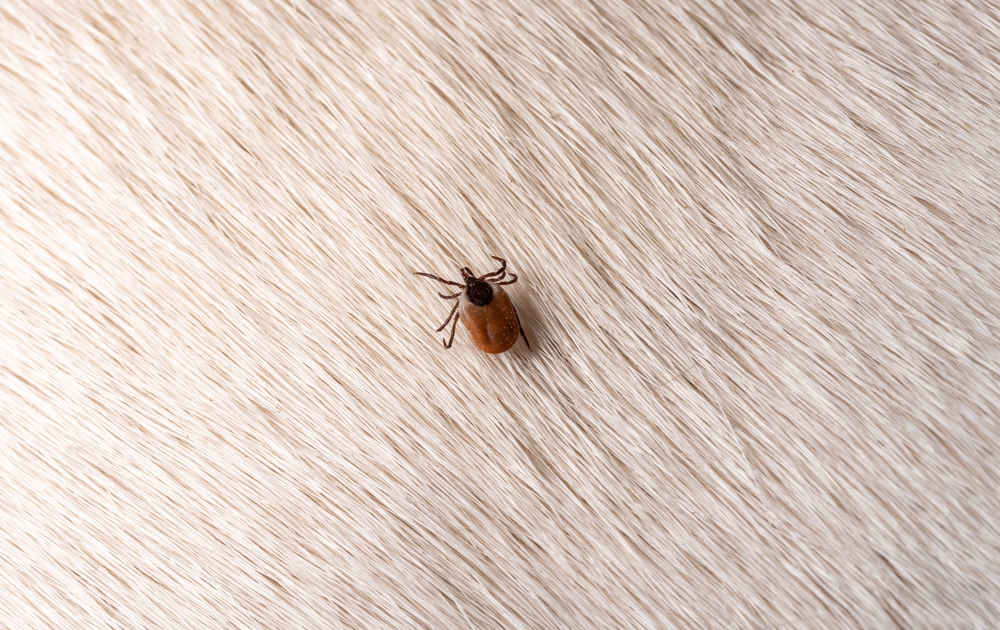Tick-borne Lyme disease is an infection that can affect people and pets. According to the Ohio Department of Health, Lyme disease cases are increasing in our state, as the black-legged (i.e., deer) tick population continues to expand—particularly in forested areas. Transmitted through an infected tick’s bite, Lyme disease is a year-round threat to pets. Learn to protect your pet from these tiny but troublesome pests by reading our Willow Wood Animal Hospital team’s guide to Lyme disease prevention.
What is Lyme disease in pets?
Lyme disease is caused by the spiral-shaped bacterium Borrelia burgdorferi, which is transmitted to pets through an infected tick’s bite. Once transmitted, the bacteria spread throughout your pet’s body, causing chronic painful joint swelling and inflammation, heart damage, kidney failure, and neurologic problems.
Where do ticks live?
Ticks can survive in a variety of climates, but they thrive in warm, humid environments. Ticks usually inhabit heavily wooded areas, grassy areas with tall brush, and near water. A large wildlife population—such as deer and rodents—provides plenty of opportunities for a tick’s next meal, as these animals are natural hosts.
Is my pet at risk for Lyme disease?
Lyme disease most often affects dogs, horses, and people. You cannot contract Lyme disease from your dog, and the disease is much less common in cats. The transmission risk is the highest for pets and people who spend a lot of time outdoors, particularly in areas that have a large tick population. Ticks rest in a questing position on the tips of grasses or shrubs with their upper legs outstretched, waiting to snag onto an animal or human when they brush against the plant.
What are the signs of Lyme disease in pets?
Infection typically occurs 24 to 48 hours after a bite, but an infected pet may not show signs for weeks or months—and many pets show no signs. By the time pets’ signs manifest, the disease has often progressed. At this time, signs may include:
- Fever
- Inappetence
- Swollen joints
- Lameness
- Swollen lymph nodes
- Lethargy
If Lyme disease progresses and is left untreated, neurologic signs, including seizures, are common, as well as kidney failure, which is often fatal. Because only 5% to 10% of infected pets exhibit signs, diagnosing Lyme disease can be challenging if annual screening tests are not performed. To ensure your pet is protected or to detect the disease before the condition progresses, our Willow Wood Animal Hospital team recommends you have your pet tested annually for tick-borne diseases.

How is Lyme disease diagnosed in pets?
Your veterinarian will draw a blood sample to test your pet for Lyme disease exposure. However, a pet may not test positive for four to six weeks after their initial infection. Your veterinarian may also recommend additional diagnostics, such as joint fluid analysis, X-rays, and urinalysis, to determine whether your pet has a Lyme disease infection.
How is Lyme disease treated in pets?
Lyme disease can be challenging to treat, and involves administering antibiotics to eliminate the Borrelia burgdorferi bacteria. In addition, your veterinarian may recommend supportive care, including pain medications, anti-inflammatory drugs, and intravenous fluids. Treatment takes about four weeks, and while antibiotics are effective at clearing the infection, Lyme disease-induced organ or joint damage (e.g., arthritis, stiffness) may persist, necessitating additional therapy or care.
How can I protect my pet from Lyme disease?
The best way to protect your pet against Lyme disease is to ensure they receive year-round parasite prevention. Because only a single tick bite can transmit Lyme disease, we recommend regularly administered parasite prevention for year-round protection and peace of mind. Ticks are mobile parasites that can easily hitch a ride into your home, also putting an indoor pet at risk. Therefore, all pets should receive year-round parasite prevention. Remember, when you and your pet are outdoors, stay in areas with short grass and few trees. After spending time outdoors, always check your pet thoroughly for ticks. These pests can attach anywhere on your pet’s body, but common places include under their tail, in their groin and armpit areas, between their toes, in their ears, and under their collar.
Protect your pet from Lyme disease by ensuring they receive parasite preventives year-round. If your pet is due for their annual screening test, or you would like to discuss which parasite preventive is best for your four-legged friend, schedule an appointment with our Willow Wood Animal Hospital team.







Leave A Comment